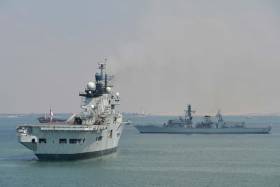Displaying items by tag: Type 23 frigate
#Westminster - A British Royal Naval Type 23 frigate that docked in Dublin Port is half-way through a three-day courtesy call to the capital, writes Jehan Ashmore.
The Duke class HMS Westminster (F237) has returned to recent active service following an extensive upkeep and trails period.
This involved dry-docking the Sea Wolf Guided Missiles equipped frigate in Portsmouth Dockyard. The extensive upgrade took place to the frigates combat and weapon systems. The works were carried out on the 133m frigate by BAE Systems.
The refit also enabled a thorough overhaul of the frigate’s main propulsion systems that delivers a speed of 28 knots.
Also work to hull was subjected to repairs and preventative maintenance. This is to ensure the vessel will be in the best possible condition for years ahead of operational duties.
HMS Westminster follows in the wake of another naval visitor of the Belgium Navy, BNS Castor designated a Ready Duty Ship (RDS).
At the beginning of this week the UK Ambassador to Belgium was on board the RDS off Zeebrugge. This was to mark the 30th anniversary of a ferry disaster that took place off the North Sea port.
The Ready Duty Ship departed the port today upon completion of a longer extended four-day shore leave. This saw the RDS occupy a city-centre berth. As for HMS Westminster the vessel berthed downriver along Ocean Pier.
Duke-Class Frigate Docks In Dublin
She measures 133m (436ft) long and on a beam of 16.1m (52.9ft) and has a crew compliment of 185 in total. An array of highly sophisticated arnament is packed on board in addition she can convey a Lynx helicopter. Propulsion is derived from a combined use of diesel and gas (CODLAG) .To read more about the penultimate Type 23 class and her sisters click HERE

























































